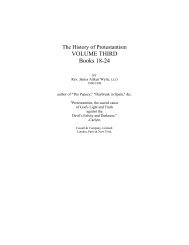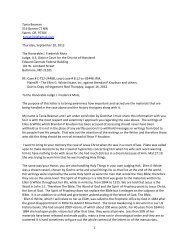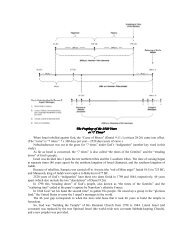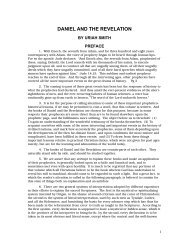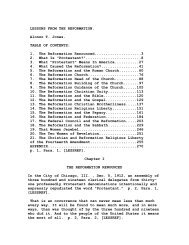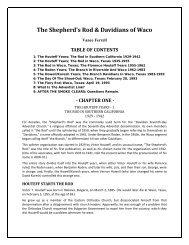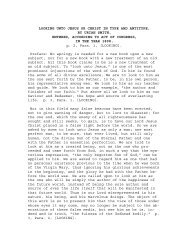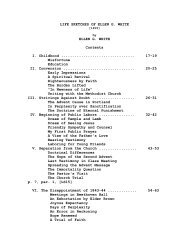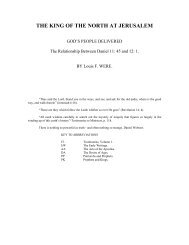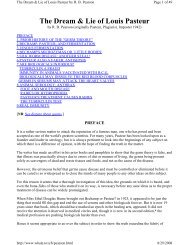History of Jesuits
History of Jesuits
History of Jesuits
You also want an ePaper? Increase the reach of your titles
YUMPU automatically turns print PDFs into web optimized ePapers that Google loves.
Chapter 10<br />
RESTORATION OF THE INQUISITION.<br />
Failure <strong>of</strong> Ratisbon Conference—What Next to be Done?—Restore the Inquisition—Paul III—Caraffa—His<br />
<strong>History</strong>—Spread <strong>of</strong> Protestantism in Italy—Juan di Valdez—His Reunions at Chiaja—Peter Martyr Vermigli—<br />
Bernardino Ochino—Galeazzo CaraccioliVittoria Colonna, etc.—Pietro Carnesecchi, etc.—Shall Naples or<br />
Geneva Lead in the Reform Movement?<br />
THERE is one arm <strong>of</strong> the <strong>Jesuits</strong> to which we have not yet adverted. The weapon that we refer to was not<br />
indeed unknown to former times, but it had fallen out <strong>of</strong> order, and had to be refurbished, and made fit for<br />
modern exigencies. No small part <strong>of</strong> the success that attended the operations <strong>of</strong> the <strong>Jesuits</strong> was owing to their<br />
use <strong>of</strong> it. That weapon was the Inquisition.<br />
We have narrated in a former chapter the earnest attempt made at the Conference <strong>of</strong> Ratisbon to find a basis<br />
<strong>of</strong> conciliation between the Protestant and the Popish churches. The way had been paved at Rome for this<br />
attempted reconcilement <strong>of</strong> the two creeds by an infusion <strong>of</strong> new blood into the College <strong>of</strong> Cardinals. Gaspar<br />
Contarini, a senator <strong>of</strong> Venice, who was known to hold opinions on the doctrine <strong>of</strong> justification differing very<br />
little, if at all, from those <strong>of</strong> Luther,1 was invested with the purple <strong>of</strong> the cardinalate. The chair <strong>of</strong> the Doge<br />
almost within his reach, Contarini was induced to come to Rome and devote the influence <strong>of</strong> his high character<br />
and great talents to the doubtful experiment <strong>of</strong> reforming the Papacy. By his advice, several ecclesiastics<br />
whose sentiments approximated to his own were added to the Sacred College, among other Sadoleto, Gioberto<br />
Caraffa, and Reginald Pole.<br />
In the end, these new elections but laid a basis for a more determined and bloody resistance to Protestantism.<br />
This was in the future as yet; meanwhile the reforming measures, for which this change in the cardinalate was<br />
to pave the way, were taken. Deputies were sent to the Ratisbon Conference, with instructions to make such<br />
concessions to the Reformers as might not endanger the fundamental principles <strong>of</strong> the Papacy, or strip the<br />
tiara <strong>of</strong> its supremacy. The issue was what we have announced in a previous part <strong>of</strong> our history. When the<br />
deputies returned from the Diet, and told Paul III that all their efforts to frame a basis <strong>of</strong> agreement between<br />
the two faiths had proved abortive, and that there was not a country in Christendom where Protestantism was<br />
not spreading, the Pope asked in alarm, “What then is to be done?” Cardinal Caraffa, and John Alvarez de<br />
Toledo, Bishop <strong>of</strong> Burgos, to whom the question was addressed, immediately made answer, Re-establish the<br />
Inquisition.<br />
The proposal accorded well with the gloomy genius, unbending opinions, and stern bigotry <strong>of</strong> the men from<br />
whom it came. Caraffa and Toledo were old Dominicans, the same order to whom Innocent III had committed<br />
the working <strong>of</strong> the “Holy Tribunal,” when it was first set up. Men <strong>of</strong> pure but austere life, they were prepared<br />
to endure in their own persons, or to inflict on the persons <strong>of</strong> others, any amount <strong>of</strong> suffering and pain, rather<br />
than permit the Roman Church to be overthrown. Re-establish the Inquisition, said Caraffa; let the supreme<br />
tribunal be set up in Rome, with subordinate branches ramifying over all Europe. “Here in Rome must the<br />
successors <strong>of</strong> Peter destroy all the heresies <strong>of</strong> the whole world.”2 The Jesuit historians take care to tell us that<br />
Caraffa’s proposal was seconded by a special memorial from the founder <strong>of</strong> their order, Ignatius Loyola. The<br />
bull re-establishing the Inquisition was published July 21st, 1542.<br />
The “Holy Office” revived with terrors unknown to it in former ages. It had now a plenitude <strong>of</strong> power. Its<br />
jurisdiction extended over all countries, and not a man in all Christendom, however exalted in rank or dignity,<br />
but was liable to be made answerable at its bar. The throne was no protection; the altar was no shield;<br />
withered age and blooming youth, matron and maiden, might any hour be seized by its familiars, and undergo



